Monitoring of Land Use/Land Cover and Socioeconomic Changes in South China over the Last Three Decades Using Landsat and Nighttime Light Data
Abstract
1. Introduction
2. Materials and Methods
2.1. Study Area
2.2. Data Acquisition and Preprocessing
2.2.1. Landsat Data
2.2.2. DMSP/OLS NTL Data
2.2.3. Other Data Sets
2.3. Land Use Land Cover Classification from Landsat Images
2.4. Change Detection from Classification Map
2.5. Light Index from DMSP NTL data
3. Results
3.1. LULC Changes from 1986 to 2017
3.2. Socioeconomic Change
4. Discussion
4.1. Driving Forces of LULCC: The Link Between Socioeconomic Factors and LULC
4.2. Consequence of LULCC: Farmland Reduction and Replacement
4.3. Benefits of LULCC: Forest Cover Increases
4.4. Recommendation for Sustainable Development and Open Space Protection
5. Conclusions
Supplementary Materials
Author Contributions
Funding
Acknowledgments
Conflicts of Interest
References
- Mooney, H.A.; Duraiappah, A.; Larigauderie, A. Evolution of natural and social science interactions in global change research programs. Proc. Natl. Acad. Sci. USA 2013, 110, 3665–3672. [Google Scholar] [CrossRef] [PubMed]
- Liu, J.; Kuang, W.; Zhang, Z.; Xu, X.; Qin, Y.; Ning, J.; Zhou, W.; Zhang, S.; Li, R.; Yan, C.; et al. Spatiotemporal characteristics, patterns, and causes of land-use changes in China since the late 1980s. J. Geogr. Sci. 2014, 24, 195–210. [Google Scholar] [CrossRef]
- Tian, H.; Chen, G.; Zhang, C.; Liu, M.; Sun, G.; Chappelka, A.; Ren, W.; Xu, X.; Lu, C.; Pan, S.; et al. Century-Scale Responses of Ecosystem Carbon Storage and Flux to Multiple Environmental Changes in the Southern United States. Ecosystems 2012, 15, 674–694. [Google Scholar] [CrossRef]
- Dou, P.; Chen, Y. Dynamic monitoring of land-use/land-cover change and urban expansion in Shenzhen using Landsat imagery from 1988 to 2015. Int. J. Remote Sens. 2017, 38, 5388–5407. [Google Scholar] [CrossRef]
- Wu, Y.; Li, S.; Yu, S. Monitoring urban expansion and its effects on land use and land cover changes in Guangzhou city, China. Environ. Monit. Assess. 2016, 188, 54. [Google Scholar] [CrossRef] [PubMed]
- Salih, A.A.M.; Ganawa, E.-T.; Elmahl, A.A. Spectral mixture analysis (SMA) and change vector analysis (CVA) methods for monitoring and mapping land degradation/desertification in arid and semiarid areas (Sudan), using Landsat imagery. Egypt. J. Remote Sens. Sp. Sci. 2017, 20, S21–S29. [Google Scholar] [CrossRef]
- Yu, W.; Zhou, W.; Qian, Y.; Yan, J. A new approach for land cover classification and change analysis: Integrating backdating and an object-based method. Remote Sens. Environ. 2016, 177, 37–47. [Google Scholar] [CrossRef]
- Zhu, Z.; Fu, Y.; Woodcock, C.E.; Olofsson, P.; Vogelmann, J.E.; Holden, C.; Wang, M.; Dai, S.; Yu, Y. Including land cover change in analysis of greenness trends using all available Landsat 5, 7 and 8 images: A case study from Guangzhou, China (2000–2014). Remote Sens. Environ. 2016, 185, 243–257. [Google Scholar] [CrossRef]
- Zhu, Z.; Woodcock, C.E. Continuous change detection and classification of land cover using all available Landsat data. Remote Sens. Environ. 2014, 144, 152–171. [Google Scholar] [CrossRef]
- Fan, F.; Weng, Q.; Wang, Y. Land Use and Land Cover Change in Guangzhou, China, from 1998 to 2003, Based on Landsat TM/ETM+ Imagery. Sensors 2007, 7, 1323–1342. [Google Scholar] [CrossRef]
- Li, C.; Kuang, Y.; Huang, N.; Zhang, C. The long-term relationship between population growth and vegetation cover: An empirical analysis based on the panel data of 21 cities in Guangdong province, China. Int. J. Environ. Res. Public Health 2013, 10, 660–677. [Google Scholar] [CrossRef] [PubMed]
- Li, X.; Yeh, A.G. Analyzing spatial restructuring of land use patterns in a fast growing region using remote sensing and GIS. Landsc. Urban Plan. 2004, 69, 335–354. [Google Scholar] [CrossRef]
- Lin, G.C.S.; Ho, S.P.S. China’s land resources and land-use change: Insights from the 1996 land survey. Land Use Policy 2003, 20, 87–107. [Google Scholar] [CrossRef]
- Du, S.; Shi, P.; Van Rompaey, A. The Relationship between Urban Sprawl and Farmland Displacement in the Pearl River Delta, China. Land 2014, 3, 34–51. [Google Scholar] [CrossRef]
- Jiang, C.; Wu, Z. Impacts of urbanization on net primary productivity in the Pearl River Delta, China. Int. J. Plant Prod. 2015, 9, 581–598. [Google Scholar]
- Hu, J.; Zhang, Y. Seasonal change of land-use/land-cover (LULC) detection using modis data in rapid urbanization regions: A case study of the pearl river delta region (China). IEEE J. Sel. Top. Appl. Earth Obs. Remote Sens. 2013, 6, 1913–1920. [Google Scholar] [CrossRef]
- Li, L.; Wang, Y. Land Use/Cover Change from 2001 to 2010 and its Socioeconomic Determinants in Guangdong Province, a Rapid Urbanization Area of China. J. Agric. Sci. 2015, 86. [Google Scholar] [CrossRef]
- Wenhua, L. Degradation and restoration of forest ecosystems in China. For. Ecol. Manag. 2004, 201, 33–41. [Google Scholar] [CrossRef]
- Dewan, A.M.; Yamaguchi, Y. Land use and land cover change in Greater Dhaka, Bangladesh: Using remote sensing to promote sustainable urbanization. Appl. Geogr. 2009, 29, 390–401. [Google Scholar] [CrossRef]
- Al-Bakri, J.T.; Duqqah, M.; Brewer, T. Application of Remote Sensing and GIS for Modeling and Assessment of Land Use/Cover Change in Amman/Jordan. J. Geogr. Inf. Syst. 2013, 5, 509–519. [Google Scholar] [CrossRef]
- Seto, K.C.; Woodcock, C.E.; Song, C.; Huang, X.; Lu, J.; Kaufmann, R.K. Monitoring land-use change in the Pearl River Delta using Landsat TM. Int. J. Remote Sens. 2002, 23, 1985–2004. [Google Scholar] [CrossRef]
- Özyavuz, M.; Onur, Ş.; Bilgili, B.C. A change vector analysis technique to monitor land-use/land-cover in the yildiz mountains, Turkey. Fresenius Environ. Bulletin 2011, 20, 1190–1199. [Google Scholar]
- Treitz, P.M.; Howarth, P.J.; Gong, P. Application of satellite and GIS technologies for land-cover and land-se mapping at the rural-urban fringe: A case study. Photogramm. Eng. Remote Sens. 1992, 58, 439–448. [Google Scholar]
- Xu, H.; Wang, X.; Xiao, G. A remote sensing and GIS integrated study on urbanization with its impact on arable lands: Fuqing City, Fujian Province, China. Land. Degrad. Dev. 2000, 11, 301–314. [Google Scholar] [CrossRef]
- Xiao, J.; Shen, Y.; Ge, J.; Tateishi, R.; Tang, C.; Liang, Y.; Huang, Z. Evaluating urban expansion and land use change in Shijiazhuang, China, by using GIS and remote sensing. Landsc. Urban Plan. 2006, 75, 69–80. [Google Scholar] [CrossRef]
- Dewan, A.M.; Corner, R.J. Spatiotemporal Analysis of Urban Growth, Sprawl and Structure. In Dhaka Megacity; Dewan, A., Corner, R., Eds.; Springer: Dordrecht, The Netherlands, 2014; pp. 99–121. ISBN 978-94-007-6735-5. [Google Scholar]
- Poelmans, L.; Van Rompaey, A. Detecting and modelling spatial patterns of urban sprawl in highly fragmented areas: A case study in the Flanders-Brussels region. Landsc. Urban Plan. 2009, 93, 10–19. [Google Scholar] [CrossRef]
- Haque, M.I.; Basak, R. Land cover change detection using GIS and remote sensing techniques: A spatio-temporal study on Tanguar Haor, Sunamganj, Bangladesh. Egypt. J. Remote Sens. Sp. Sci. 2017, 20, 251–263. [Google Scholar] [CrossRef]
- Hussain, M.; Chen, D.; Cheng, A.; Wei, H.; Stanley, D. Change detection from remotely sensed images: From pixel-based to object-based approaches. ISPRS J. Photogramm. Remote Sens. 2013, 80, 91–106. [Google Scholar] [CrossRef]
- Seto, K.C.; Fragkias, M. Quantifying spatiotemporal patterns of urban land-use change in four cities of China with time series landscape metrics. Landsc. Ecol. 2005, 20, 871–888. [Google Scholar] [CrossRef]
- Chen, J.; Gong, P.; He, C.; Pu, R.; Shi, P. Land-Use/Land-Cover Change Detection Using Improved Change-Vector Analysis. Photogramm. Eng. Remote Sens. 2003, 69, 369–379. [Google Scholar] [CrossRef]
- Fan, F.; Wang, Y.; Wang, Z. Temporal and spatial change detecting (1998–2003) and predicting of land use and land cover in Core corridor of Pearl River Delta (China) by using TM and ETM+ images. Environ. Monit. Assess. 2008, 137, 127–147. [Google Scholar] [CrossRef]
- Dai, J.; Wang, K.; Gao, X. Spatial structure and land use control in Extended Metropolitan Region of Zhujiang River Delta, China. Chin. Geogr. Sci. 2010, 20, 298–308. [Google Scholar] [CrossRef]
- Weng, Q. Land use change analysis in the Zhujiang Delta of China using satellite remote sensing, GIS and stochastic modelling. J. Environ. Manag. 2002, 64, 273–284. [Google Scholar] [CrossRef]
- Sodango, T.H.; Sha, J.; Li, X. Land Use/Land Cover Change (LULCC) in China, Review of Studies. Int. J. Sci. Eng. Res. 2017, 8, 943–958. [Google Scholar]
- Ma, Y.; Xu, R. Remote sensing monitoring and driving force analysis of urban expansion in Guangzhou City, China. Habitat Int. 2010, 34, 228–235. [Google Scholar] [CrossRef]
- Seto, K.C.; Kaufmann, R.K. Modeling the Drivers of Urban Land Use Change in the Pearl River Delta, China: Integrating Remote Sensing with Socioeconomic Data. Land Econ. 2003, 79, 106–121. [Google Scholar] [CrossRef]
- Wang, J.; Lin, Y.; Glendinning, A.; Xu, Y. Land-use changes and land policies evolution in China’s urbanization processes. Land Use Policy 2018, 75, 375–387. [Google Scholar] [CrossRef]
- Wang, J.; Chen, Y.; Shao, X.; Zhang, Y.; Cao, Y. Land-use changes and policy dimension driving forces in China: Present, trend and future. Land Use Policy 2012, 29, 737–749. [Google Scholar] [CrossRef]
- Zhang, H.; Chen, Y.; Zhou, J. Assessing the long-term impact of urbanization on run-off using a remote-sensing-supported hydrological model. Int. J. Remote Sens. 2015, 36, 5336–5352. [Google Scholar] [CrossRef]
- Mountrakis, G.; Im, J.; Ogole, C. Support vector machines in remote sensing: A review. ISPRS J. Photogramm. Remote Sens. 2011, 66, 247–259. [Google Scholar] [CrossRef]
- Liu, Q.; Guo, Y.; Liu, G.; Zhao, J. Classification of landsat 8 OLI image using support vector machine with tasseled cap transformation. In Proceedings of the 2014 10th International Conference on Natural Computation (ICNC), Xiamen, China, 19–21 August 2014; IEEE: Piscataway, NJ, USA, 2014; pp. 670–674. [Google Scholar]
- Bahari, N.I.S.; Ahmad, A.; Aboobaider, B.M. Application of support vector machine for classification of multispectral data. IOP Conf. Ser. Earth Environ. Sci. 2014, 20. [Google Scholar] [CrossRef]
- Pal, M.; Mather, P.M. Support vector machines for classification in remote sensing. Int. J. Remote Sens. 2005, 26, 1007–1011. [Google Scholar] [CrossRef]
- Ustuner, M.; Sanli, F.B.; Dixon, B. Application of support vector machines for landuse classification using high-resolution rapideye images: A sensitivity analysis. Eur. J. Remote Sens. 2015, 48, 403–422. [Google Scholar] [CrossRef]
- Gidudu, A.; Hulley, G.; Marwala, T. Classification of Images Using Support Vector Machines. arXiv 2007, arXiv:0709.3967v1. [Google Scholar]
- Candade, N.; Dixon, D.B. Multispectral Classification of Landsat Images: A Comparison of Support Vector Machine and Neural Network Classifiers. In Proceedings of the ASPRS Annual Conference Proceeding, Denver, CO, USA, 23–28 May 2004; p. 12. [Google Scholar]
- Mohammadimanesh, F.; Salehi, B.; Mahdianpari, M.; Motagh, M.; Brisco, B. An Efficient Feature Optimization for Wetland Mapping by Synergistic Use of SAR Intensity, Interferometry, and Polarimetry Data. Int. J. Appl. Earth Obs. Geoinf. 2018, 73, 450–462. [Google Scholar] [CrossRef]
- Griffiths, P.; Hostert, P.; Gruebner, O.; van der Linden, S. Mapping megacity growth with multi-sensor data. Remote Sens. Environ. 2010, 114, 426–439. [Google Scholar] [CrossRef]
- Huang, C.; Song, K.; Kim, S.; Townshend, J.R.G.; Davis, P.; Masek, J.G.; Goward, S.N. Use of a dark object concept and support vector machines to automate forest cover change analysis. Remote Sens. Environ. 2008, 112, 970–985. [Google Scholar] [CrossRef]
- Hao, M.; Shi, W.; Deng, K.; Zhang, H.; He, P. An Object-Based Change Detection Approach Using Uncertainty Analysis for VHR Images. J. Sens. 2016, 2016, 1–17. [Google Scholar] [CrossRef]
- Megahed, Y.; Cabral, P.; Silva, J.; Caetano, M. Land Cover Mapping Analysis and Urban Growth Modelling Using Remote Sensing Techniques in Greater Cairo Region—Egypt. ISPRS Int. J. Geo-Inf. 2015, 4, 1750–1769. [Google Scholar] [CrossRef]
- Devadas, R.; Denham, R.J.; Pringle, M. Support Vector Machine Classification of Object-Based Data for Crop Mapping, Using Multi-Temporal Landsat Imagery. ISPRS Int. Arch. Photogramm. Remote Sens. Spat. Inf. Sci. 2012, XXXIX-B7, 185–190. [Google Scholar] [CrossRef]
- Xiowei, X.; Xiangxin, C.; Jianfu, Y. Guangdong Statistics Yearbook 2017; China Statistics Press: Beijing, China, 2017. [Google Scholar]
- Shobairi, S.O.; Li, M. Dynamic Modelling of VFC from 2000 to 2010 Using NDVI and DMSP/OLS Time Series: A Study in Guangdong Province, China. J. Geogr. Inf. Syst. 2016, 8, 205–223. [Google Scholar] [CrossRef][Green Version]
- Chen, Y.; Li, X.; Liu, X.; Ai, B. Analyzing land-cover change and corresponding impacts on carbon budget in a fast developing sub-tropical region by integrating MODIS and Landsat TM/ETM+ images. Appl. Geogr. 2013, 45, 10–21. [Google Scholar] [CrossRef]
- USGS Earth Explorer. Available online: https://earthexplorer.usgs.gov/ (accessed on 28 February 2018).
- National Centers for Environmental Information. Available online: https://ngdc.noaa.gov/eog/dmsp/downloadV4composites.html (accessed on 7 July 2018).
- Shi, K.; Chen, Y.; Yu, B.; Xu, T.; Li, L.; Huang, C.; Liu, R.; Chen, Z.; Wu, J. Urban Expansion and Agricultural Land Loss in China: A Multiscale Perspective. Sustainability 2016, 8, 790. [Google Scholar] [CrossRef]
- Li, X.; Zhou, Y. Urban mapping using DMSP/OLS stable night-time light: A review. Int. J. Remote Sens. 2017. [Google Scholar] [CrossRef]
- Pandey, B.; Joshi, P.K.; Seto, K.C. Monitoring urbanization dynamics in India using DMSP/OLS night time lights and SPOT-VGT data. Int. J. Appl. Earth Obs. Geoinf. 2013, 23, 49–61. [Google Scholar] [CrossRef]
- Faouzi, B.; Washaya, P. Tracking dynamic changes and monitoring socioeconomic parameters in Algeria between 1993 and 2012, using nighttime light remote sensing. In Proceedings of the the International Archives of the Photogrammetry, Remote Sensing and Spatial Information Sciences, Wuhan, China, 18–22 September 2017; Volume XLII, pp. 18–22. [Google Scholar]
- Elvidge, C.; Hsu, F.-C.; Baugh, K.; Ghosh, T. National Trends in Satellite-Observed Lighting: 1992–2012. In Global Urban Monitoring and Assessment through Earth Observation; CRC Press: Boca Raton, FL, USA, 2014; pp. 97–120. [Google Scholar]
- Jiang, W.; He, G.; Long, T.; Wang, C.; Ni, Y.; Ma, R. Assessing Light Pollution in China Based on Nighttime Light Imagery. Remote Sens. 2017, 9, 135. [Google Scholar] [CrossRef]
- Zhang, Q.; Seto, K.C. Mapping urbanization dynamics at regional and global scales using multi-temporal DMSP/OLS nighttime light data. Remote Sens. Environ. 2011, 115, 2320–2329. [Google Scholar] [CrossRef]
- Burges, C.J. A Tutorial on Support Vector Machines for Pattern Recognition. Data Min. Knowl. Discov. 1998, 2, 121–167. [Google Scholar] [CrossRef]
- Rimal, B.; Zhang, L.; Keshtkar, H.; Haack, B.; Rijal, S.; Zhang, P. Land Use/Land Cover Dynamics and Modeling of Urban Land Expansion by the Integration of Cellular Automata and Markov Chain. ISPRS Int. J. Geo-Inf. 2018, 7, 154. [Google Scholar] [CrossRef]
- Abbas, S.; Nichol, J.E.; Wong, M.S. Object-based, multi-sensor habitat mapping of successional age classes for effective management of a 70-year secondary forest succession. Land Use Policy 2018, 1–10. [Google Scholar] [CrossRef]
- Lillesand, T.; Kiefer, R.W.; Chipman, J.W. Remote Sensing and Image Interpretation, 6th ed.; John Wiley & Sons: Hoboken, NJ, USA, 2008. [Google Scholar]
- Resources and Environment Data Cloud Platform. Available online: http://www.resdc.cn/Default.aspx (accessed on 10 September 2018).
- Pontius, R.G.; Shusas, E.; McEachern, M. Detecting important categorical land changes while accounting for persistence. Agric. Ecosyst. Environ. 2004, 101, 251–268. [Google Scholar] [CrossRef]
- Puyravaud, J. Standardizing the calculation of the annual rate of deforestation. Ecol. Manag. 2003, 177, 593–596. [Google Scholar] [CrossRef]
- Teferi, E.; Bewket, W.; Uhlenbrook, S.; Wenninger, J. Understanding recent land use and land cover dynamics in the source region of the Upper Blue Nile, Ethiopia: Spatially explicit statistical modeling of systematic transitions. Agric. Ecosyst. Environ. 2013, 165, 98–117. [Google Scholar] [CrossRef]
- Wei, Y.; Liu, H.; Song, W.; Yu, B.; Xiu, C. Normalization of time series DMSP-OLS nighttime light images for urban growth analysis with pseudo invariant features. Landsc. Urban Plan. 2014, 128, 1–13. [Google Scholar] [CrossRef]
- Zhang, Q.; Pandey, B.; Seto, K.C. A Robust Method to Generate a Consistent Time Series from DMSP/OLS Nighttime Light Data. IEEE Trans. Geosci. Remote Sens. 2016, 54, 5821–5831. [Google Scholar] [CrossRef]
- Ramakrishnan, P.S.; George, P.S.; Kulkarni, S.; Vashishtha, P.S.; Shidong, Z.; Qiguo, Z.; Wenmei, C.; Yi, Z.; Wolman, M.G.; Long, J.F.; et al. Growing Populations, Changing Landscapes; National Academies Press: Washington, DC, USA, 2001; ISBN 978-0-309-07554-1. [Google Scholar]
- Liu, Z.; Huang, H.; Werners, S.E.; Yan, D. Construction area expansion in relation to economic-demographic development and land resource in the Pearl River Delta of China. J. Geogr. Sci. 2016, 26, 188–202. [Google Scholar] [CrossRef]
- Ng, M.K.; Hang Hui, D.L. Practice report: Sustainability impact assessment in Hong Kong and the Pearl River Delta: “both necessary and impossible”? Impact Assess. Proj. Apprais. 2007, 25, 233–238. [Google Scholar] [CrossRef]
- Bai, X.; Chen, J.; Shi, P. Landscape Urbanization and Economic Growth in China: Positive Feedbacks and Sustainability Dilemmas. Environ. Sci. Technol. 2012, 46, 132–139. [Google Scholar] [CrossRef] [PubMed]
- Bui, T.; Yang, D.; Jones, W.; Li, J. China’s Economic Powerhouse: Economic Reform in Guangdong Province; Palgrave Macmillan: New York, NY, USA, 2003. [Google Scholar]
- Chokkalingam, U.; Zhou, Z.; Toma, T. Learning Lessons from China’s Forest Rehabilitation Efforts National Level Review and Special Focus on Guangdong Province; Center for International Forestry Research: Jakarta, Indonesia, 2006; ISBN 9792446672. [Google Scholar]
- Trac, C.J.; Schmidt, A.H.; Harrell, S.; Hinckley, T.M. Is the Returning Farmland to Forest Program a Success? Three Case Studies from Sichuan. Environ. Pr. 2013, 15, 350–366. [Google Scholar] [CrossRef]
- Peng, S.; Hou, Y.; Chen, B. Vegetation Restoration and Its Effects on Carbon Balance in Guangdong Province, China. Restor. Ecol. 2008, 17, 487–494. [Google Scholar] [CrossRef]
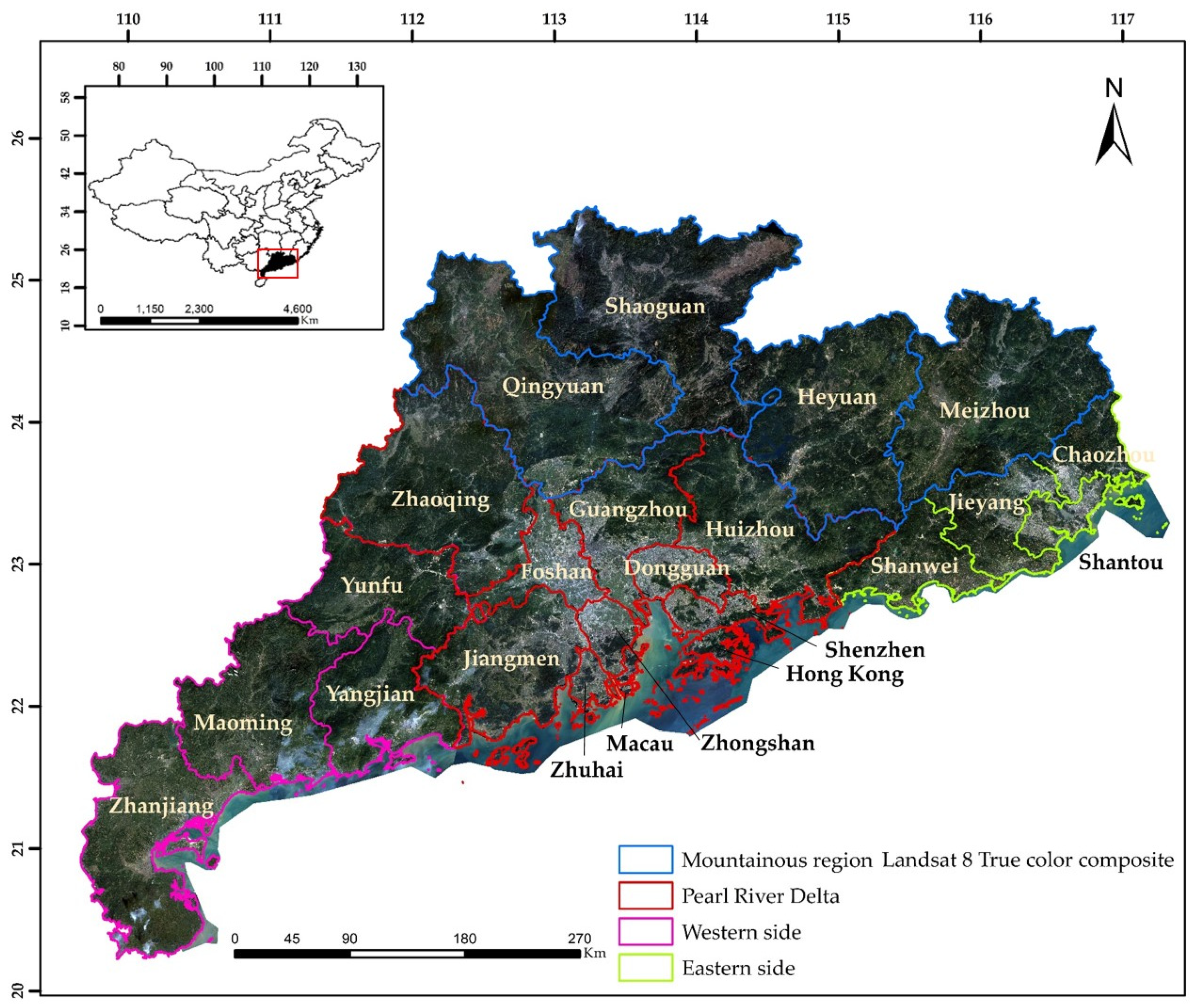
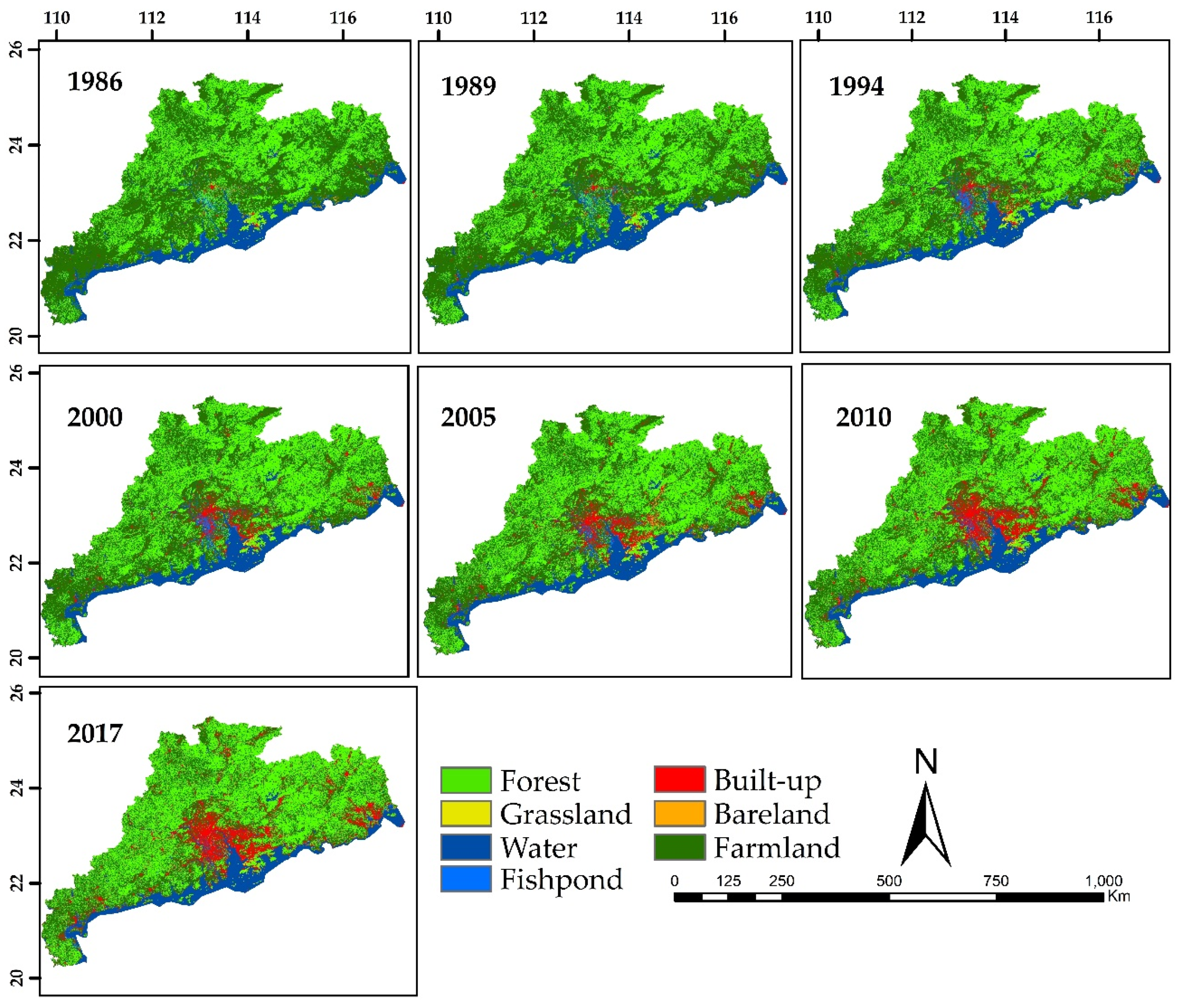
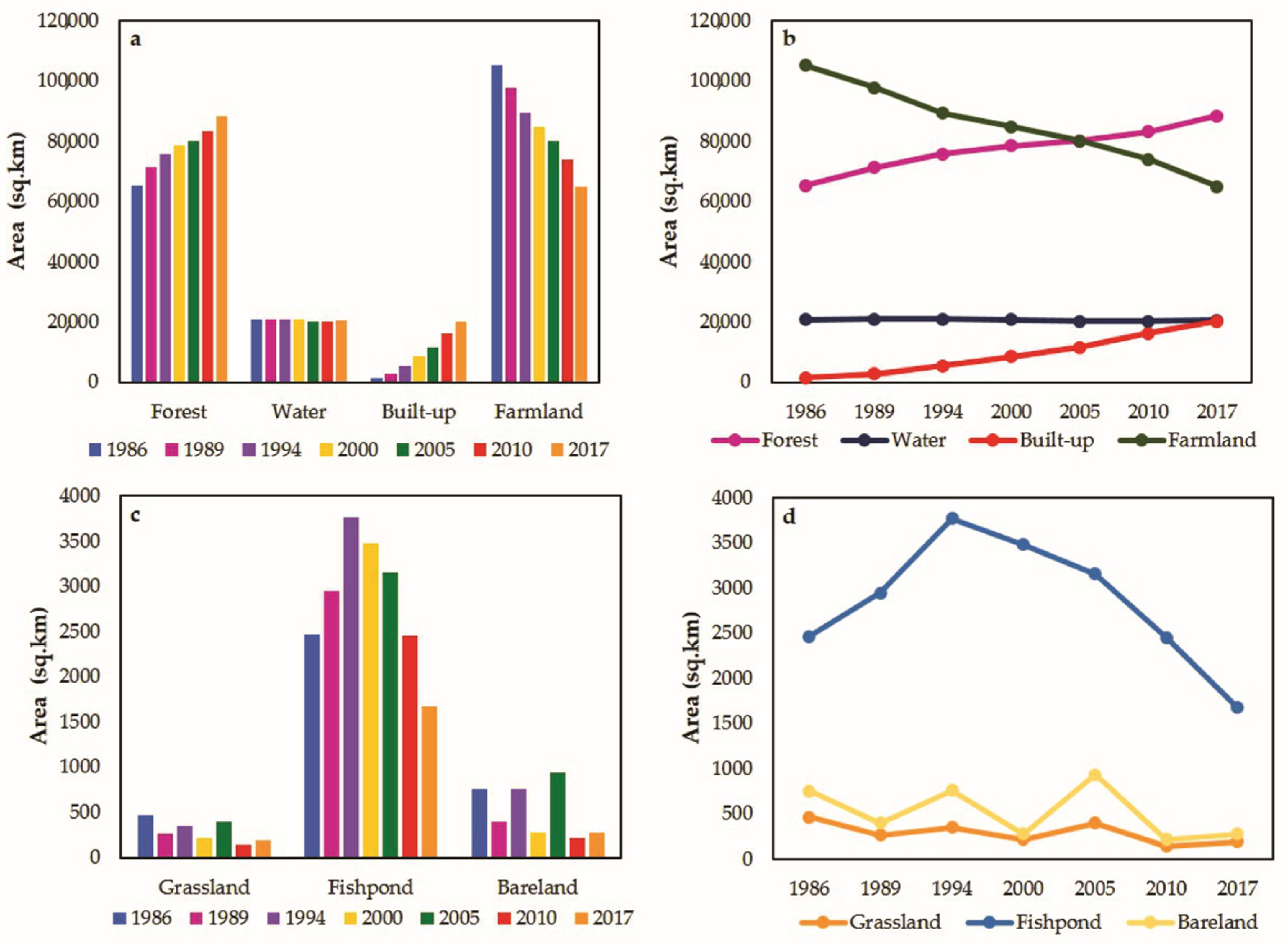
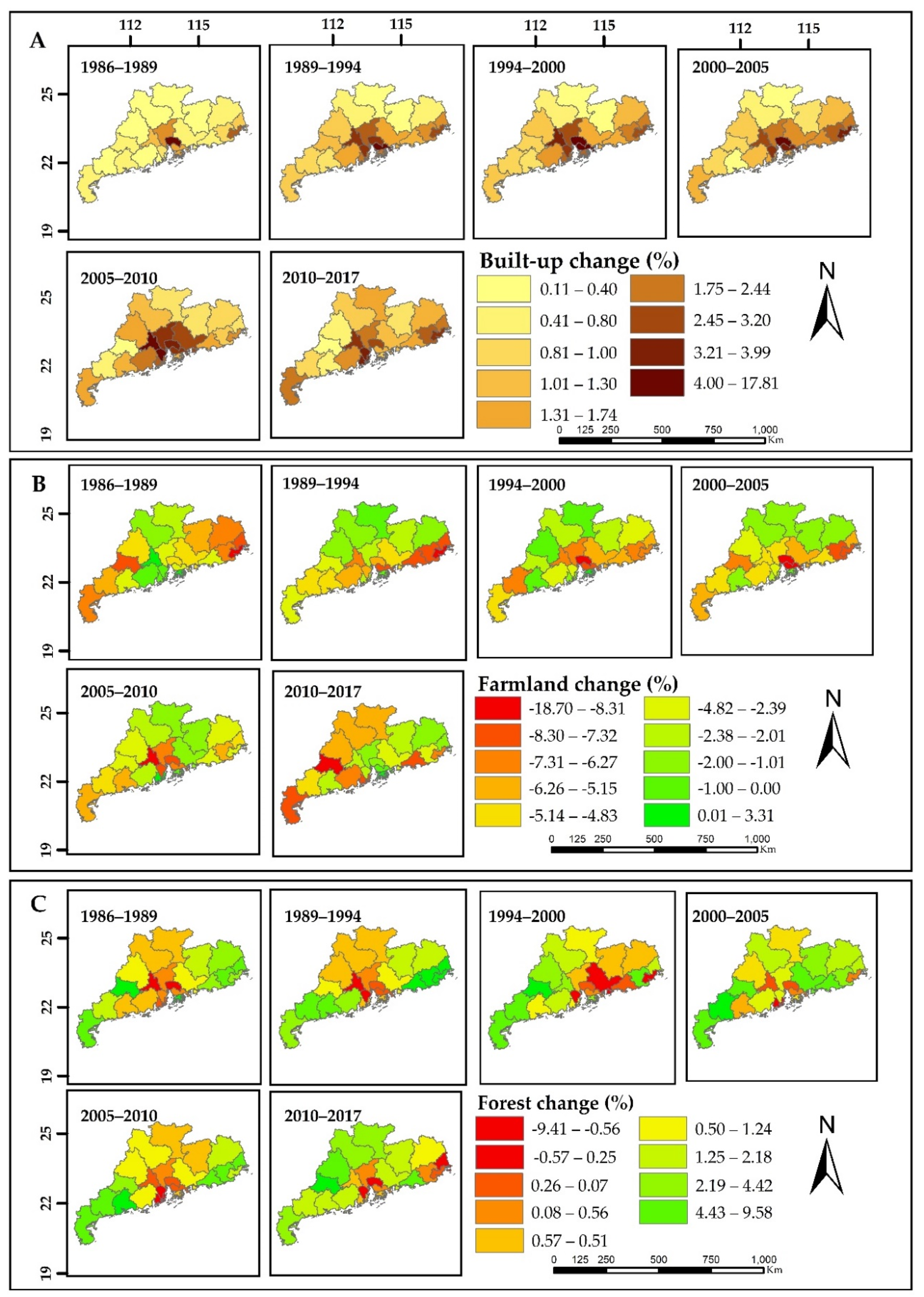
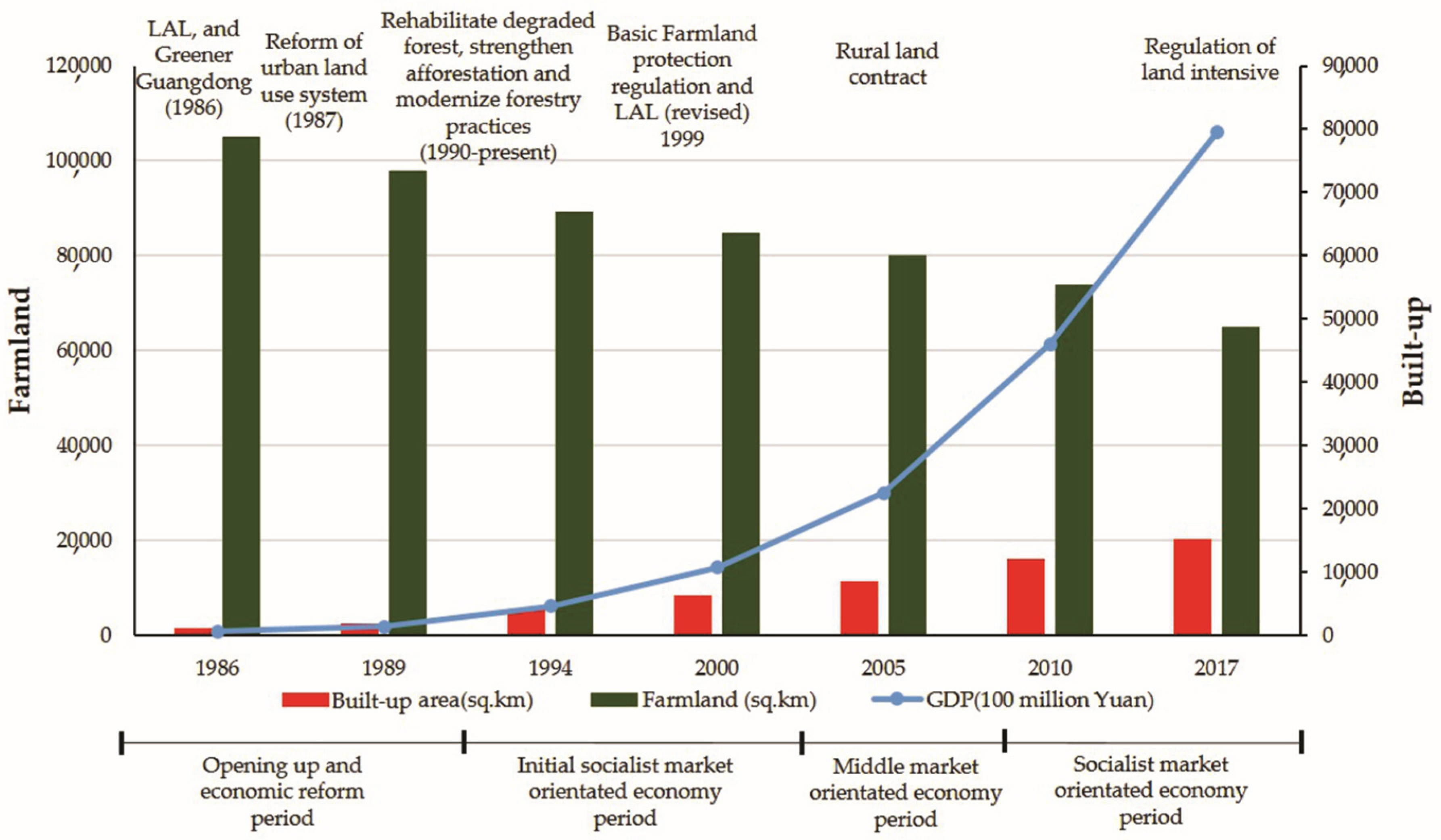
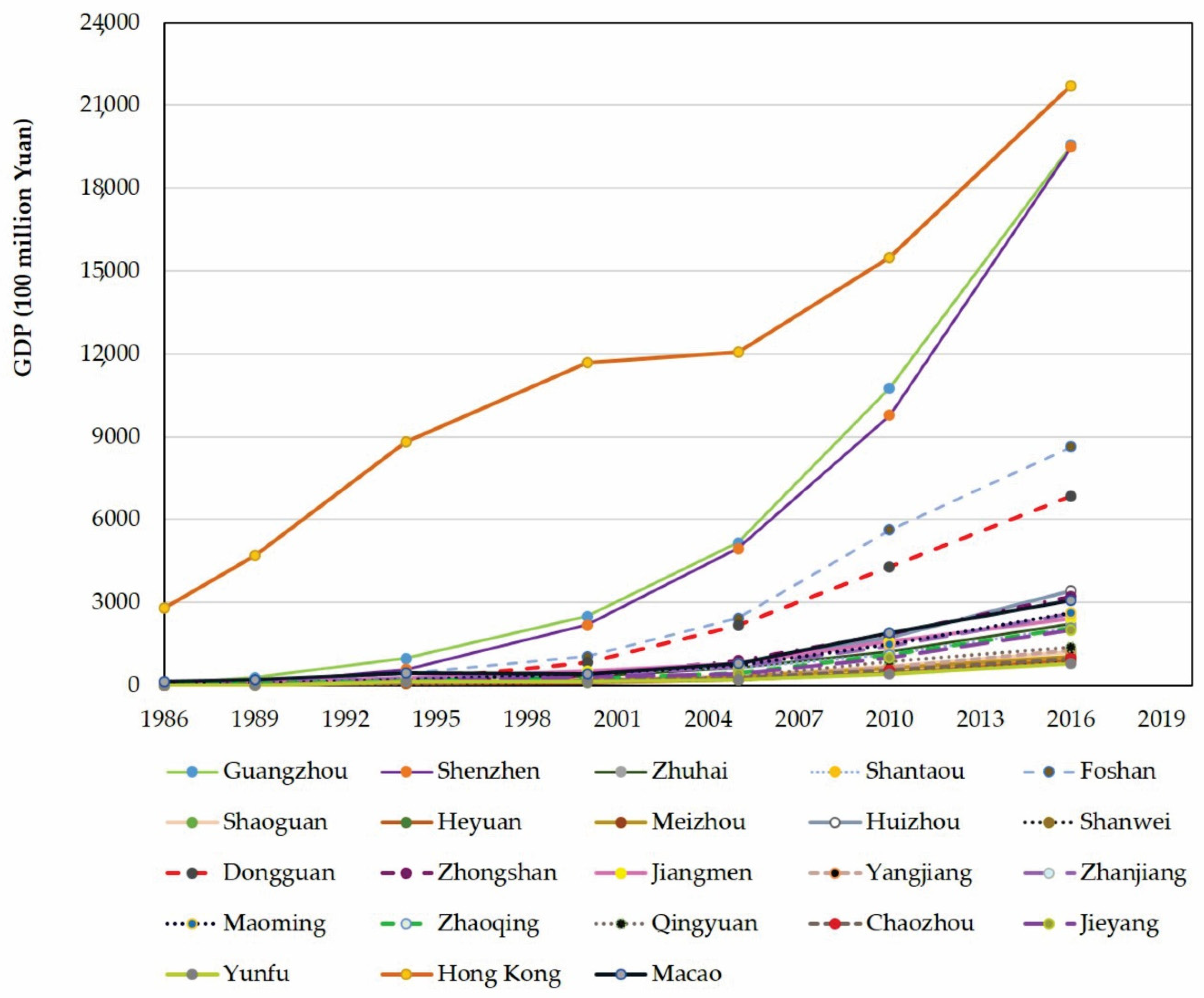
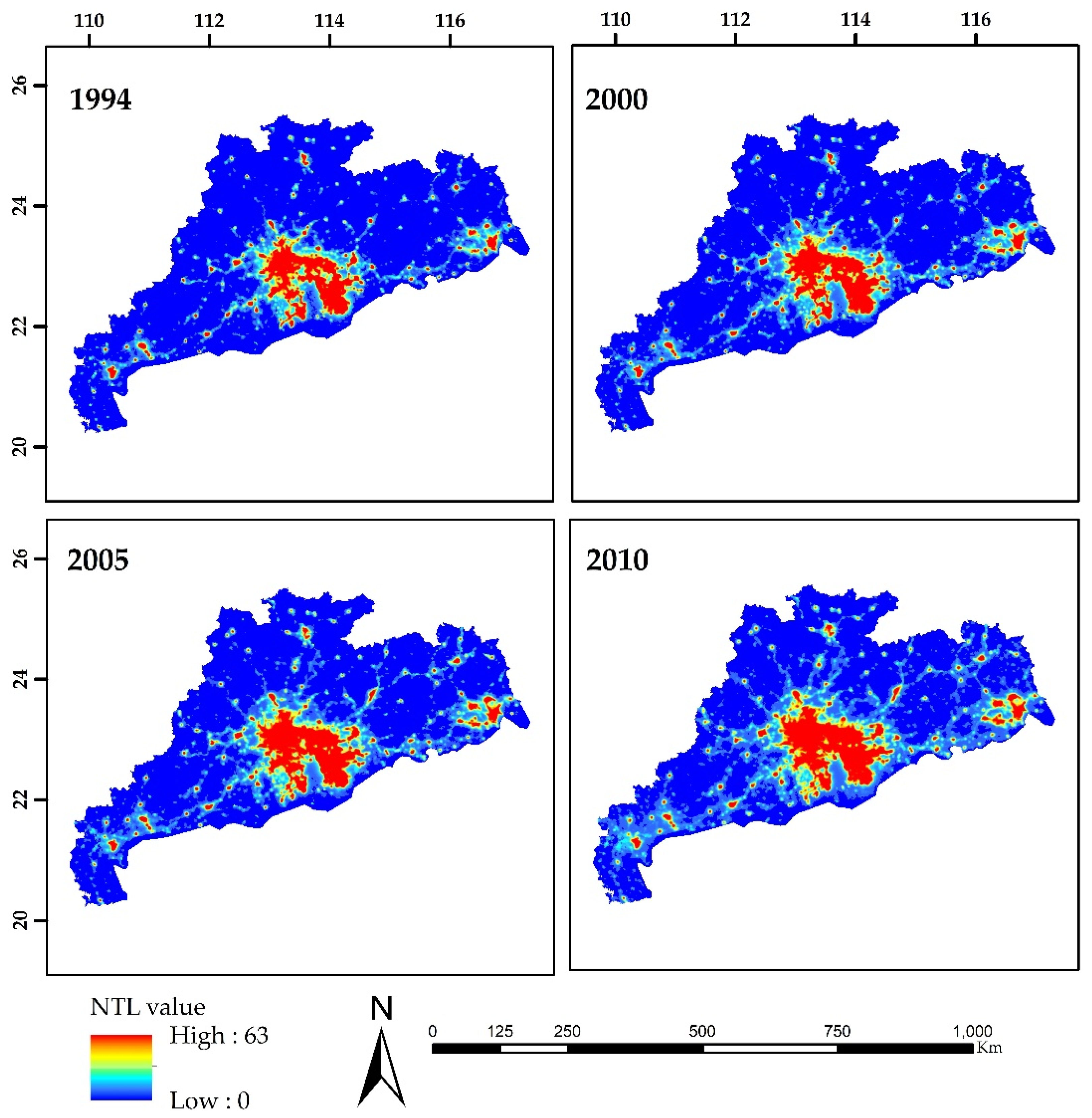
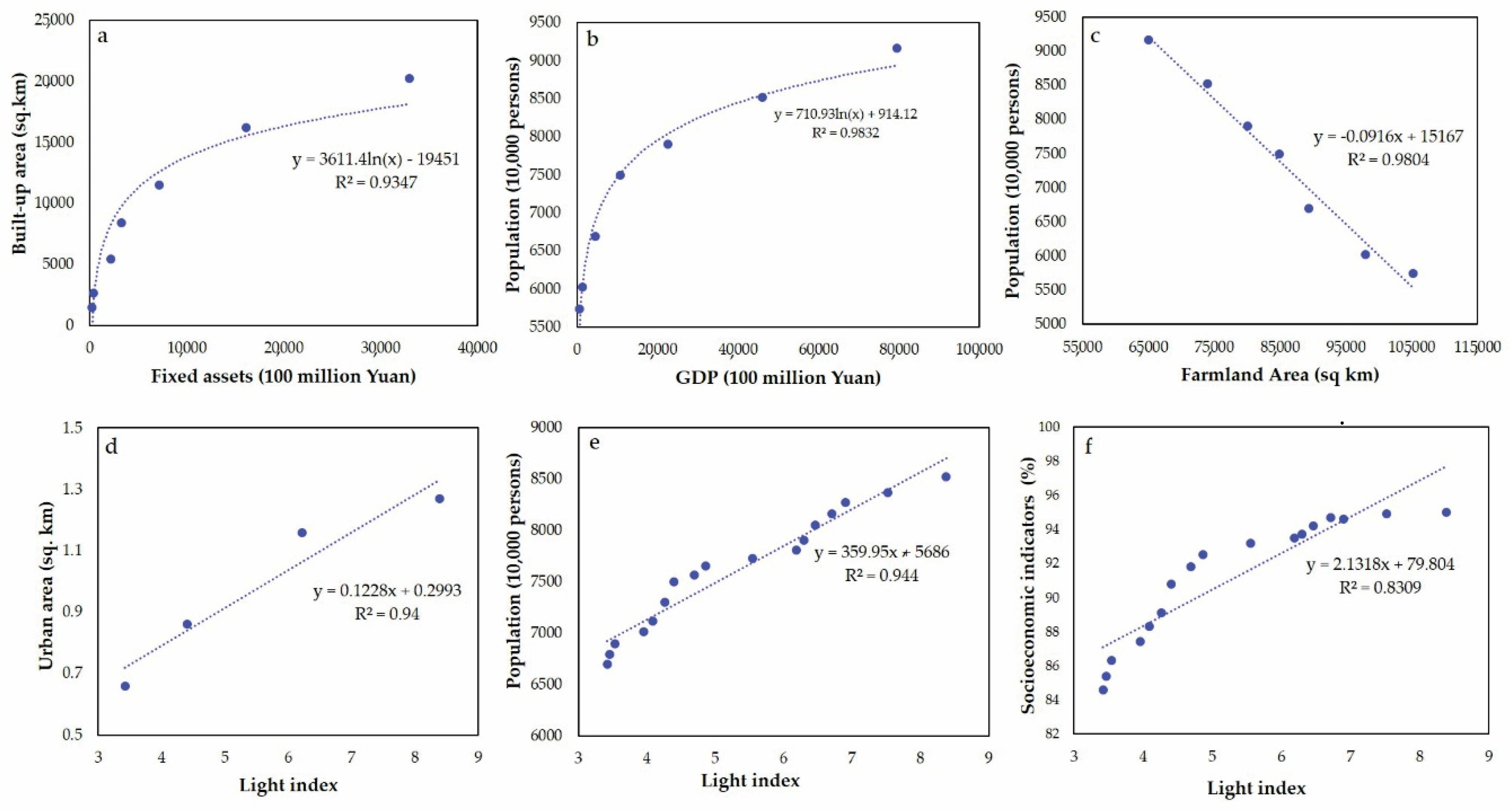
| Class | Description | Abbreviation |
|---|---|---|
| Forest | Forest, tree cover | F |
| Grassland | Natural shrubs and grassland | G |
| Water | Natural water bodies, oceans, lakes, rivers, and reservoir. Water bodies that are not used for intensive aquaculture | W |
| Fishponds | Water bodies that are used for intensive aquaculture. Dike pond, including mulberry | FP |
| Built-up | Land covered by buildings and other man-made structures | BU |
| Bareland | Exposed soil, sand, rocks, landfill sites, areas of active excavation | BL |
| Farmland | Land used for farming, cropland, orchards | FL |
| 1986–1989 | 1989–1994 | 1994–2000 | 2000–2005 | 2005–2010 | 2010–2017 | 1986–2017 | |
|---|---|---|---|---|---|---|---|
| (% Change Per Year) | |||||||
| Forest | 2.95 | 1.23 | 0.58 | 0.42 | 0.75 | 0.86 | 0.98 |
| Grassland | −19.02 | 6.51 | −8.21 | 11.96 | −21.00 | 5.10 | −2.69 |
| Water | 0.19 | −0.02 | −0.19 | −0.50 | 0.06 | 0.30 | −0.02 |
| Fishponds | 6.08 | 4.94 | −1.36 | −2.02 | −4.94 | −5.51 | −1.24 |
| Built-up | 19.15 | 14.37 | 7.21 | 6.26 | 6.93 | 3.17 | 8.41 |
| Bareland | −21.40 | 13.36 | −17.08 | 24.64 | −29.47 | 3.45 | −3.22 |
| Farmland | −2.38 | −1.83 | −0.86 | −1.16 | −1.60 | −1.85 | −1.55 |
| 1986 | 1989 | 1994 | 2000 | 2005 | 2010 | 2017 | |
|---|---|---|---|---|---|---|---|
| Gross Domestic Product (100 million Yuan) | 667.53 | 1381.39 | 4619.02 | 10,741.25 | 22,557.37 | 46,036.25 | 79,512.05 |
| Primary Industry | 188.37 | 351.73 | 692.25 | 986.32 | 1428.27 | 2286.98 | 3694.37 |
| Secondary Industry | 255.88 | 554.13 | 2253.25 | 4999.51 | 11,356.60 | 22,821.77 | 34,001.31 |
| Tertiary Industry | 223.28 | 475.53 | 1673.52 | 4755.42 | 9772.50 | 20,927.50 | 41,816.37 |
| Total Population (10,000 persons) | 5740.70 | 6024.98 | 6691.46 | 7498.54 | 7899.64 | 8521.55 | 9164.90 |
| Total Investment in Fixed Assets (100 million yuan) | 216.50 | 347.34 | 2141.15 | 3233.70 | 7164.11 | 16,113.19 | 33,008.86 |
| Government Revenue (100 million yuan) | 82.41 | 136.87 | 298.70 | 910.56 | 1807.20 | 4517.04 | 10,390.35 |
| Gross Agricultural output value (100 million yuan) | 279.15 | 548.60 | 1151.38 | 1701.18 | 2447.57 | 3754.86 | 6078.43 |
| Gross Industrial output value (100 million yuan) | 632.89 | 1647.24 | 7273.95 | 16,904.47 | 41,661.74 | 93,462.97 | 144,926.10 |
| Total Retail Sales of Consumer Good (100 million yuan) | 327.02 | 636.15 | 1991.33 | 4379.81 | 7915.51 | 17,458.44 | 34,739.00 |
| 1986−1989 | 1989−1994 | 1994−2000 | 2000−2005 | 2005−2010 | 2010−2017 | |
|---|---|---|---|---|---|---|
| Population growth rate (%) | 4.95 | 11.06 | 12.06 | 5.35 | 7.87 | 7.55 |
| Year | Light Index | NTL* Built-Up Area (km2) | Average | SDV ** |
|---|---|---|---|---|
| 1994 | 3.42 | 7860 | 53.00 | 4.77 |
| 2000 | 4.40 | 1024 | 52.84 | 4.90 |
| 2005 | 6.21 | 15,104 | 54.27 | 4.53 |
| 2010 | 8.38 | 17,431 | 55.34 | 4.07 |
| Years | Periods | Land Use Policies | Issues |
|---|---|---|---|
| 1978−1991 | Opening up and economic reform | Local entrepreneurship | Initial productivity but effect development of town and village enterprises |
| 1992−2002 | Initial period of the socialist market-oriented economy | Farmland protection and land-use planning | Conflict over farmland protection and land development |
| 2003−2008 | Mid-term of the socialist market-oriented economy | Urbanization and regional development Regulating land markets, use rights and property law | Uneven urban-rural and regional social and economic development |
| 2009−now | Socialist market-oriented economy | Intensive land use under construction of civilization Regulating land markets, use rights and property | Conflict over farmland conversion, protection and land development Uneven urban–rural and regional social and economic development |
© 2019 by the authors. Licensee MDPI, Basel, Switzerland. This article is an open access article distributed under the terms and conditions of the Creative Commons Attribution (CC BY) license (http://creativecommons.org/licenses/by/4.0/).
Share and Cite
Hasan, S.; Shi, W.; Zhu, X.; Abbas, S. Monitoring of Land Use/Land Cover and Socioeconomic Changes in South China over the Last Three Decades Using Landsat and Nighttime Light Data. Remote Sens. 2019, 11, 1658. https://doi.org/10.3390/rs11141658
Hasan S, Shi W, Zhu X, Abbas S. Monitoring of Land Use/Land Cover and Socioeconomic Changes in South China over the Last Three Decades Using Landsat and Nighttime Light Data. Remote Sensing. 2019; 11(14):1658. https://doi.org/10.3390/rs11141658
Chicago/Turabian StyleHasan, Sarah, Wenzhong Shi, Xiaolin Zhu, and Sawaid Abbas. 2019. "Monitoring of Land Use/Land Cover and Socioeconomic Changes in South China over the Last Three Decades Using Landsat and Nighttime Light Data" Remote Sensing 11, no. 14: 1658. https://doi.org/10.3390/rs11141658
APA StyleHasan, S., Shi, W., Zhu, X., & Abbas, S. (2019). Monitoring of Land Use/Land Cover and Socioeconomic Changes in South China over the Last Three Decades Using Landsat and Nighttime Light Data. Remote Sensing, 11(14), 1658. https://doi.org/10.3390/rs11141658









